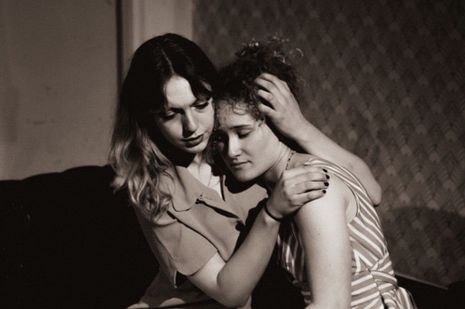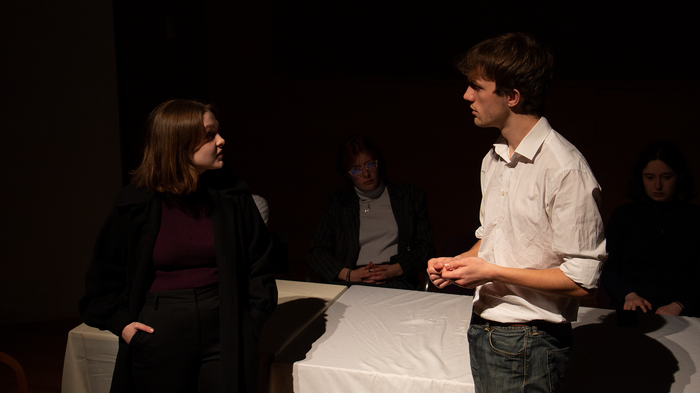The Captive brings a piece of queer history to life
Writer Charlie Butler reviews The Captive at the Corpus Playroom

Édouard Bourdet’s ground-breaking 1926 play The Captive explores sexuality and love in early-20th-century Paris (don’t worry – the actors don’t try to do French accents). Its claim to fame is being the first Broadway play to explicitly portray lesbianism, which it does so through the character of Irene, who fakes an engagement to a friend, Jacques, in order to stay in Paris with her lover. If you choose to witness the ensuing love-hexagon for yourself, you will be treated to a production which is, in many ways, very impressive. However, I would encourage you to manage your expectations about the play itself.
The performances given by the eight actors involved were consistently impressive. This is a very wordy play, so even getting through the dialogue with minimal stumbling should be considered something of an achievement. With so many lengthy, dialogue-heavy, two-person scenes, the play occasionally found itself in danger of becoming rather one-note. The most enjoyable performances were given by the actors who were not afraid to dramatically vary their tone in order to present the complexities of their character. Fuschia Webb’s portrayal of the flirtatious yet heartbroken Francoise was particularly impressive in this regard, particularly when played against the alternately noble and deeply unsympathetic Jacques (Alix Addinall).
"The costumes are all absolutely gorgeous and complemented the characters entirely"
Perhaps the most remarkable thing about this play was the way in which a young, all-female/nonbinary cast was able to convincingly portray characters of all ages and genders. This was largely achieved through the establishment of clear dynamics between the characters. In an early scene featuring Irene (Lily-Rose Morris-Zumin) and her father Montcel (Kitty Ford), the two actors portray their fraught relationship with such fantastic precision that one has to be forcefully reminded that they are in fact the same age.
The design is wonderful. The play was first written and performed in the 1920s, and this production stays true to that era. The costumes are all absolutely gorgeous and complemented the characters entirely. The set dressing instantly evoked the 1920s upper-class Parisian apartments in which all the action of the play takes place, with the obligatory chaise-longue taking centre stage. Lighting was simple yet effective, and the incidental music was fitting and helped to establish such a convincingly era-appropriate atmosphere that one could almost imagine themselves to be watching The Captive’s first ever performance.
"It offers a fascinating insight into early portrayals of queer lives and stories in theatre"
Unfortunately, no amount of acting talent, production value or even swanky costumes can disguise the fact that this is a very, very boring play. It is over two hours long, and consists solely of back-to-back scenes in which two characters who are slightly annoyed at each other pace around the stage exchanging repetitive, passive-aggressive dialogue until a butler enters to announce the arrival of another character, whereupon one of the present characters will leave and the next will enter and the whole awful cycle will begin again. The entire business could have been done in under an hour and – if they were good at quick costume changes – with about two actors.
Personally, I thought that the choice to have an all-female/nonbinary cast was largely effective in recentring the unbalanced gender-dynamics of the play – which was, after all, written by a man. However, a more cynical soul might suggest that this was a sneaky move designed to disguise the fact that what is sometimes described as the first Broadway play ‘about lesbianism’ is actually – for the most part – about the feelings of a man. In fact, Irene’s sexuality is only portrayed in terms of the suffering it causes her and those around her – Jacques in particular – and her lover’s only physical presence in the play is a vase of violets which sits quietly on a side table. If it’s a story of boundless queer joy you want, this ain’t it.
I am both aware of the significance of The Captive and grateful for its legacy. In fact, I’m glad to have seen it, as it offers a fascinating insight into early portrayals of queer lives and stories in theatre. I’m especially glad to have seen this version, which I would sum-up as the best possible presentation of a very mediocre script.
This play is undeniably a piece of history, but maybe it should be left there from now on.
The Captive is playing at the Corpus Playroom until Saturday 19th March.
 News / SU reluctantly registers controversial women’s soc18 December 2025
News / SU reluctantly registers controversial women’s soc18 December 2025 News / Dons warn PM about Vet School closure16 December 2025
News / Dons warn PM about Vet School closure16 December 2025 Features / Should I stay or should I go? Cambridge students and alumni reflect on how their memories stay with them15 December 2025
Features / Should I stay or should I go? Cambridge students and alumni reflect on how their memories stay with them15 December 2025 News / Cambridge study finds students learn better with notes than AI13 December 2025
News / Cambridge study finds students learn better with notes than AI13 December 2025 Fashion / The art of the formal outfit 18 December 2025
Fashion / The art of the formal outfit 18 December 2025









